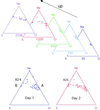Airborne minerals and related aerosol particles: effects on climate and the environment
- PMID: 10097046
- PMCID: PMC34277
- DOI: 10.1073/pnas.96.7.3372
Airborne minerals and related aerosol particles: effects on climate and the environment
Abstract
Aerosol particles are ubiquitous in the troposphere and exert an important influence on global climate and the environment. They affect climate through scattering, transmission, and absorption of radiation as well as by acting as nuclei for cloud formation. A significant fraction of the aerosol particle burden consists of minerals, and most of the remainder- whether natural or anthropogenic-consists of materials that can be studied by the same methods as are used for fine-grained minerals. Our emphasis is on the study and character of the individual particles. Sulfate particles are the main cooling agents among aerosols; we found that in the remote oceanic atmosphere a significant fraction is aggregated with soot, a material that can diminish the cooling effect of sulfate. Our results suggest oxidization of SO2 may have occurred on soot surfaces, implying that even in the remote marine troposphere soot provided nuclei for heterogeneous sulfate formation. Sea salt is the dominant aerosol species (by mass) above the oceans. In addition to being important light scatterers and contributors to cloud condensation nuclei, sea-salt particles also provide large surface areas for heterogeneous atmospheric reactions. Minerals comprise the dominant mass fraction of the atmospheric aerosol burden. As all geologists know, they are a highly heterogeneous mixture. However, among atmospheric scientists they are commonly treated as a fairly uniform group, and one whose interaction with radiation is widely assumed to be unpredictable. Given their abundances, large total surface areas, and reactivities, their role in influencing climate will require increased attention as climate models are refined.
Figures







Similar articles
-
Reduced anthropogenic aerosol radiative forcing caused by biogenic new particle formation.Proc Natl Acad Sci U S A. 2016 Oct 25;113(43):12053-12058. doi: 10.1073/pnas.1602360113. Epub 2016 Oct 10. Proc Natl Acad Sci U S A. 2016. PMID: 27790989 Free PMC article.
-
Modeling the contribution of secondary aerosols on aerosol scattering ensemble: a comparative analysis of the scattering abilities of different aerosol species.Opt Express. 2024 Jan 29;32(3):4614-4626. doi: 10.1364/OE.514164. Opt Express. 2024. PMID: 38297658
-
Tropospheric aerosols: size-differentiated chemistry and large-scale spatial distributions.J Air Waste Manag Assoc. 2013 Apr;63(4):377-404. doi: 10.1080/10962247.2012.760499. J Air Waste Manag Assoc. 2013. PMID: 23687724 Review.
-
[Observation study on aerosol optical properties and radiative forcing using the ground-based and satellite remote sensing at background station during the regional pollution episodes].Huan Jing Ke Xue. 2014 Jul;35(7):2439-48. Huan Jing Ke Xue. 2014. PMID: 25247232 Chinese.
-
Formation and evolution of aqueous organic aerosols via concurrent condensation and chemical aging.Adv Colloid Interface Sci. 2019 Mar;265:45-67. doi: 10.1016/j.cis.2019.01.001. Epub 2019 Jan 14. Adv Colloid Interface Sci. 2019. PMID: 30711797 Review.
Cited by
-
Combustion-generated nanoparticulates in the El Paso, TX, USA / Juarez, Mexico Metroplex: their comparative characterization and potential for adverse health effects.Int J Environ Res Public Health. 2006 Mar;3(1):48-66. doi: 10.3390/ijerph2006030007. Int J Environ Res Public Health. 2006. PMID: 16823077 Free PMC article.
-
Ion chemistry and individual particle analysis of atmospheric aerosols over Mt. Bogda of eastern Tianshan Mountains, Central Asia.Environ Monit Assess. 2011 Sep;180(1-4):409-26. doi: 10.1007/s10661-010-1796-6. Epub 2010 Nov 25. Environ Monit Assess. 2011. PMID: 21107902
-
Diurnal variations of airborne pollen concentration and the effect of ambient temperature in three sites of Mexico City.Int J Biometeorol. 2016 May;60(5):771-87. doi: 10.1007/s00484-015-1061-3. Epub 2015 Oct 2. Int J Biometeorol. 2016. PMID: 26431700 Review.
-
Study of the strongest dust storm occurred in Uzbekistan in November 2021.Sci Rep. 2023 Nov 16;13(1):20042. doi: 10.1038/s41598-023-42256-1. Sci Rep. 2023. PMID: 37973804 Free PMC article.
-
Characteristics of Fine Particles in an Urban Atmosphere-Relationships with Meteorological Parameters and Trace Gases.Int J Environ Res Public Health. 2016 Aug 10;13(8):807. doi: 10.3390/ijerph13080807. Int J Environ Res Public Health. 2016. PMID: 27517948 Free PMC article.
References
-
- Farquhar G D. Science. 1997;278:1411.
-
- Mahlman J D. Science. 1997;278:1416–1417.
-
- Molina M J, Molina L T, Kolb C E. Annu Rev Phys Chem. 1996;47:327–367.
-
- Charlson R J, Heintzenberg J, editors. Aerosol Forcing of Climate. New York: Wiley; 1995.
-
- Houghton J T, Meiro Filho L G, Callander B A, Harris N, Kattenberg A, Maskell K, editors. Climate Change 1995: The Science of Climate Change, Contribution of Working Group I to the Second Assessment Report of the Intergovernmental Panel on Climate Change (IPCC) Cambridge, U. K.: Cambridge Univ. Press; 1996.
LinkOut - more resources
Full Text Sources
Research Materials

